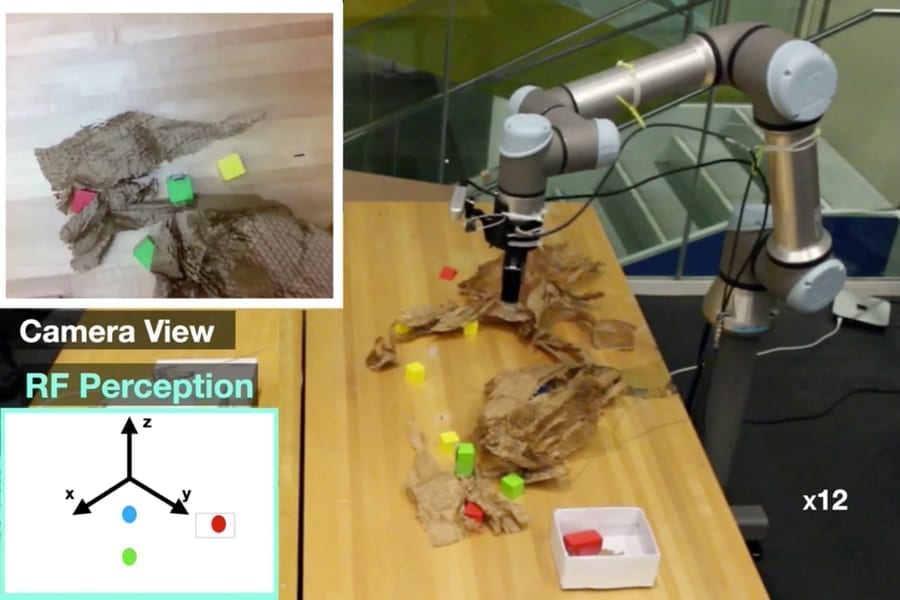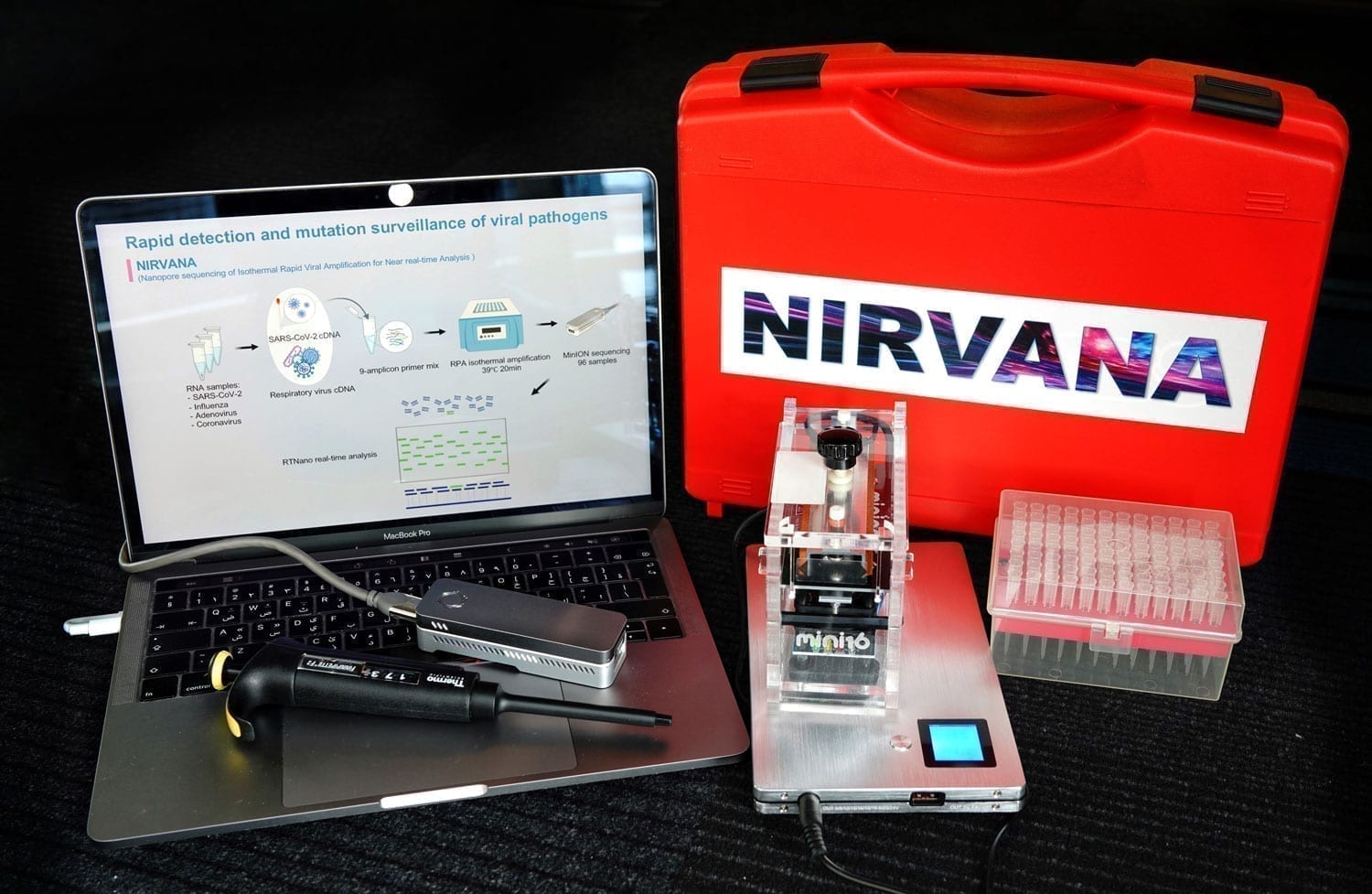
MIT researchers developed a picking robot that combines vision with radio frequency (RF) sensing to find and grasp objects, even if they’re hidden from view. The technology could aid fulfilment in e-commerce warehouses.
Images courtesy of the researchers
In recent years, robots have gained artificial vision, touch, and even smell. “Researchers have been giving robots human-like perception,” says MIT Associate Professor Fadel Adib. In a new paper, Adib’s team is pushing the technology a step further. “We’re trying to give robots superhuman perception,” he says.
The researchers have developed a robot that uses radio waves, which can pass through walls, to sense occluded objects. The robot, called RF-Grasp, combines this powerful sensing with more traditional computer vision to locate and grasp items that might otherwise be blocked from view. The advance could one day streamline e-commerce fulfillment in warehouses or help a machine pluck a screwdriver from a jumbled toolkit.
The research will be presented in May at the IEEE International Conference on Robotics and Automation. The paper’s lead author is Tara Boroushaki, a research assistant in the Signal Kinetics Group at the MIT Media Lab. Her MIT co-authors include Adib, who is the director of the Signal Kinetics Group; and Alberto Rodriguez, the Class of 1957 Associate Professor in the Department of Mechanical Engineering. Other co-authors include Junshan Leng, a research engineer at Harvard University, and Ian Clester, a PhD student at Georgia Tech.
As e-commerce continues to grow, warehouse work is still usually the domain of humans, not robots, despite sometimes-dangerous working conditions. That’s in part because robots struggle to locate and grasp objects in such a crowded environment. “Perception and picking are two roadblocks in the industry today,” says Rodriguez. Using optical vision alone, robots can’t perceive the presence of an item packed away in a box or hidden behind another object on the shelf — visible light waves, of course, don’t pass through walls.
But radio waves can.
For decades, radio frequency (RF) identification has been used to track everything from library books to pets. RF identification systems have two main components: a reader and a tag. The tag is a tiny computer chip that gets attached to — or, in the case of pets, implanted in — the item to be tracked. The reader then emits an RF signal, which gets modulated by the tag and reflected back to the reader.
The reflected signal provides information about the location and identity of the tagged item. The technology has gained popularity in retail supply chains — Japan aims to use RF tracking for nearly all retail purchases in a matter of years. The researchers realized this profusion of RF could be a boon for robots, giving them another mode of perception.
“RF is such a different sensing modality than vision,” says Rodriguez. “It would be a mistake not to explore what RF can do.”
RF Grasp uses both a camera and an RF reader to find and grab tagged objects, even when they’re fully blocked from the camera’s view. It consists of a robotic arm attached to a grasping hand. The camera sits on the robot’s wrist. The RF reader stands independent of the robot and relays tracking information to the robot’s control algorithm. So, the robot is constantly collecting both RF tracking data and a visual picture of its surroundings. Integrating these two data streams into the robot’s decision making was one of the biggest challenges the researchers faced.
“The robot has to decide, at each point in time, which of these streams is more important to think about,” says Boroushaki. “It’s not just eye-hand coordination, it’s RF-eye-hand coordination. So, the problem gets very complicated.”
The robot initiates the seek-and-pluck process by pinging the target object’s RF tag for a sense of its whereabouts. “It starts by using RF to focus the attention of vision,” says Adib. “Then you use vision to navigate fine maneuvers.” The sequence is akin to hearing a siren from behind, then turning to look and get a clearer picture of the siren’s source.
With its two complementary senses, RF Grasp zeroes in on the target object. As it gets closer and even starts manipulating the item, vision, which provides much finer detail than RF, dominates the robot’s decision making.
RF Grasp proved its efficiency in a battery of tests. Compared to a similar robot equipped with only a camera, RF Grasp was able to pinpoint and grab its target object with about half as much total movement. Plus, RF Grasp displayed the unique ability to “declutter” its environment — removing packing materials and other obstacles in its way in order to access the target. Rodriguez says this demonstrates RF Grasp’s “unfair advantage” over robots without penetrative RF sensing. “It has this guidance that other systems simply don’t have.”
RF Grasp could one day perform fulfilment in packed e-commerce warehouses. Its RF sensing could even instantly verify an item’s identity without the need to manipulate the item, expose its barcode, then scan it. “RF has the potential to improve some of those limitations in industry, especially in perception and localization,” says Rodriguez.
Adib also envisions potential home applications for the robot, like locating the right Allen wrench to assemble your Ikea chair. “Or you could imagine the robot finding lost items. It’s like a super-Roomba that goes and retrieves my keys, wherever the heck I put them.”
Original Article: A robot that senses hidden objects
More from: MIT Media Lab | Massachusetts Institute of Technology | Harvard University | Georgia Institute of Technology
The Latest Updates from Bing News & Google News
Go deeper with Bing News on:
Robot perception
- Comau showcases the power of automation with new robots and new solutions at Automate 2024
Visitors will experience the power of perception-guided picking systems, vision-backed handling solutions, Source: Comau advanced arc welding systems and wearable robotics that help increase operator ...
- This is the first humanoid electric robot that can run at 6km/h
The Beijing Humanoid Robot Innovation Center launched its electric humanoid robot “Tiangong” on Saturday. My Drivers, via Kuai Technology, reported that the launch took place in the Beijing Economic ...
- A New Era of Robotics: China Debuts First Self-Developed Humanoid Robot
China has taken a significant leap in robotics by unveiling its first domestically developed general-purpose humanoid robot, the Tiangong ...
- Chinese company unveils humanoid running robot with large-scale commercial potential
Tiangong, a humanoid robot described as the world's first full-sized humanoid robot capable of running solely on electric drive, was unveiled in the Beijing Economic-Technological Development Area on ...
- Sanctuary AI reveals seventh-generation robot it calls “analogous to a person”
Vancouver-based robotics startup Sanctuary AI has revealed the seventh generation of its general-purpose robot, Phoenix.
Go deeper with Google Headlines on:
Robot perception
[google_news title=”” keyword=”robot perception” num_posts=”5″ blurb_length=”0″ show_thumb=”left”]
Go deeper with Bing News on:
Robot RF identification
- A six-armed robot for precision pollination
Over the past decades, dozens of animal species have become extinct, while thousands of others are now at risk of disappearing. Endangered species include various pollinators, including bees and some ...
- Radio Frequency Identification (RFID): What It Is, How It Works
Radio Frequency Identification (RFID) is a technology that uses radio waves to passively identify a tagged object. It is used in several commercial and industrial applications, from tracking items ...
- What is NFC? How it works and what you can do with it
The technology behind NFC is very similar to radio-frequency identification (RFID) commonly used in the security cards and keychain fobs that you likely already use to get into your office or gym.
- Radio Frequency Identification Engineering
To save content items to your account, please confirm that you agree to abide by our usage policies. If this is the first time you use this feature, you will be asked to authorise Cambridge Core to ...
- Radio Frequency Identification Engineering
Radio frequency identification (RFID) is an undeniable aspect of modern living, being used from logistics, access control and banking to smart cities, smart transportation and as a key enabler of the ...
Go deeper with Google Headlines on:
Robot RF identification
[google_news title=”” keyword=”robot RF identification” num_posts=”5″ blurb_length=”0″ show_thumb=”left”]









